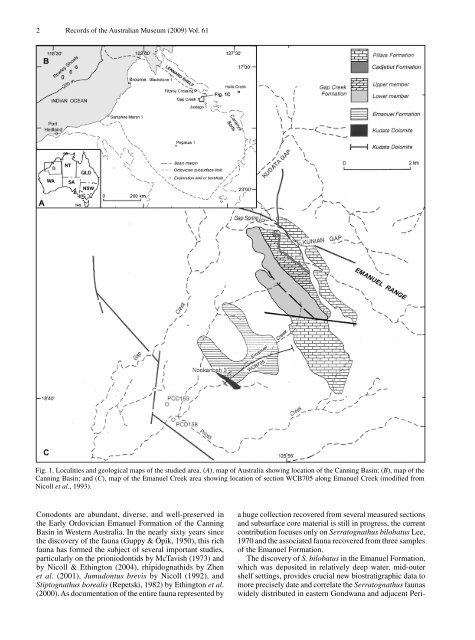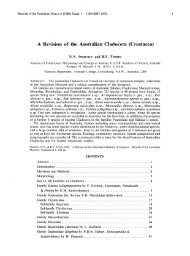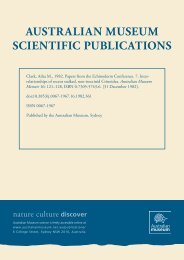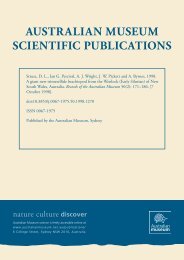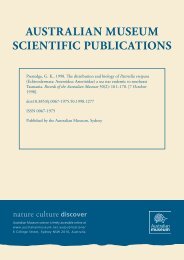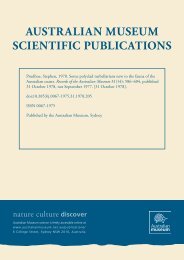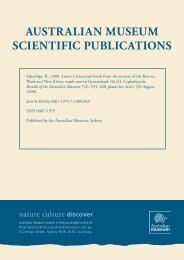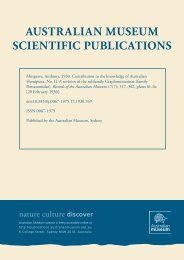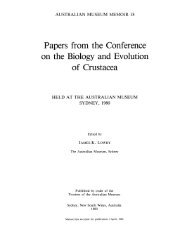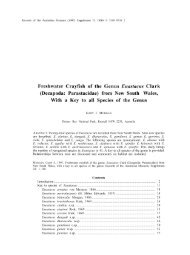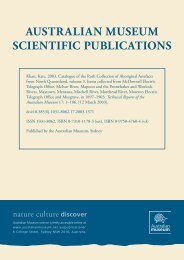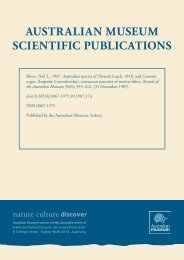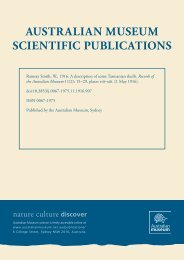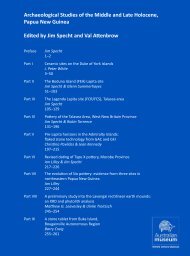Biogeographic and biostratigraphic implications of the - Australian ...
Biogeographic and biostratigraphic implications of the - Australian ...
Biogeographic and biostratigraphic implications of the - Australian ...
You also want an ePaper? Increase the reach of your titles
YUMPU automatically turns print PDFs into web optimized ePapers that Google loves.
2 Records <strong>of</strong> <strong>the</strong> <strong>Australian</strong> Museum (2009) Vol. 61<br />
Fig. 1. Localities <strong>and</strong> geological maps <strong>of</strong> <strong>the</strong> studied area. (A), map <strong>of</strong> Australia showing location <strong>of</strong> <strong>the</strong> Canning Basin; (B), map <strong>of</strong> <strong>the</strong><br />
Canning Basin; <strong>and</strong> (C), map <strong>of</strong> <strong>the</strong> Emanuel Creek area showing location <strong>of</strong> section WCB705 along Emanuel Creek (modified from<br />
Nicoll et al., 1993).<br />
Conodonts are abundant, diverse, <strong>and</strong> well-preserved in<br />
<strong>the</strong> Early Ordovician Emanuel Formation <strong>of</strong> <strong>the</strong> Canning<br />
Basin in Western Australia. In <strong>the</strong> nearly sixty years since<br />
<strong>the</strong> discovery <strong>of</strong> <strong>the</strong> fauna (Guppy & Öpik, 1950), this rich<br />
fauna has formed <strong>the</strong> subject <strong>of</strong> several important studies,<br />
particularly on <strong>the</strong> prioniodontids by McTavish (1973) <strong>and</strong><br />
by Nicoll & Ethington (2004), rhipidognathids by Zhen<br />
et al. (2001), Jumudontus brevis by Nicoll (1992), <strong>and</strong><br />
Stiptognathus borealis (Repetski, 1982) by Ethington et al.<br />
(2000). As documentation <strong>of</strong> <strong>the</strong> entire fauna represented by<br />
a huge collection recovered from several measured sections<br />
<strong>and</strong> subsurface core material is still in progress, <strong>the</strong> current<br />
contribution focuses only on Serratognathus bilobatus Lee,<br />
1970 <strong>and</strong> <strong>the</strong> associated fauna recovered from three samples<br />
<strong>of</strong> <strong>the</strong> Emanuel Formation.<br />
The discovery <strong>of</strong> S. bilobatus in <strong>the</strong> Emanuel Formation,<br />
which was deposited in relatively deep water, mid-outer<br />
shelf settings, provides crucial new <strong>biostratigraphic</strong> data to<br />
more precisely date <strong>and</strong> correlate <strong>the</strong> Serratognathus faunas<br />
widely distributed in eastern Gondwana <strong>and</strong> adjacent Peri-


